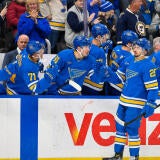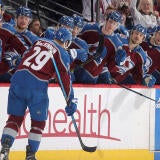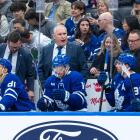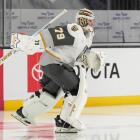WATCH: Blues' Ryan Reaves ejected for hit on Blackhawks' Ehrhoff
St. Louis Blues forward Ryan Reaves was ejected for "charging" Blackhawks defenseman Christian Ehrhoff, but was it the right call?

It was hardly surprising to see St. Louis Blues forward Ryan Reaves deliver a big hit in the first period against the Chicago Blackhawks. He’s a physical player that plays his game right on the edge. However, it was a little more surprising to see the hit ended up costing Reaves the rest of the game.
Reaves delivered the crushing hit on defenseman Christian Ehrhoff behind the Blackhawks’ net. It looked pretty bad in real time, with Reaves extending into the hit, sending Ehrhoff spinning in the air. However, the replays were a little more forgiving to the Blues player.
That hit resulted in a five-minute major for charging and a game misconduct for Reaves. It also briefly sent Ehrhoff to the Blackhawks dressing room, but he returned to the game.
In real time, the hit looks questionable at best. Slowed down, you can see why Reaves was so upset about getting the boot from a huge game for his team.
Here are the key factors to pay attention to:
1. Ehrhoff lost the handle on the puck. He was going after it when he picked his head up and saw Reaves. Anticipating the blow, Ehrhoff backed off of his pursuit and prepared for the hit. Reaves was already committed to the check, likely anticipating Ehrhoff to be reaching for the puck, and followed through. It was pretty clear, however, that Reaves had zero interest in the puck and was thinking hit the whole way.
2. Based on every angle available to us in the broadcast, there was no evidence that Reaves made contact with Ehrhoff's head. The referee that made the call was positioned behind Ehrhoff, making it near impossible for him to know for sure. When a player spins like Ehrhoff did coming out of the hit, it’s reasonable to assume head contact, but there was none here.
3. The rules for charging are a little broader, granting the referee a lot of discretion when it comes to making these calls. Here’s what Rule 42 says: “A minor or major penalty shall be imposed on a player who skates or jumps into, or charges an opponent in any manner. Charging shall mean the actions of a player who, as a result of distance traveled, shall violently check an opponent in any manner. A “charge” may be the result of a check into the boards, into the goal frame or in open ice.”
So really, it’s about the degree of violence and not necessarily whether there was or wasn't head contact, which presents a lot of leeway to the official. Additionally, when the referee assesses a major, a game misconduct is pretty much automatic at that point.
When it comes to this particular hit, it appears that Reaves’ skates remained on the ice as he delivered the hit, but came off after contact. That, said, he delivers the hit in more of a launching manner, pushing from his legs to maximize the punishment.
Was it a borderline hit? Yes. Was it worthy of a game misconduct? That’s far more subjective. The refrees are calling this in real time and can't review hits like that to double check. Based on what they saw from the angles they saw it, it's not much of a surprise. Based on all of the video angles we saw, they probably want a little too far in giving Reaves the major and the misconduct.
Because of the nature of the infraction on the ice, the NHL’s Department of Player Safety will undoubtedly review it anyway. They’ll probably look at it more carefully considering that Reaves was suspended just two weeks ago for boarding San Jose Sharks defenseman Matt Tennyson. Reaves' disciplinary history may play a role in the department’s review and it has been harder to get a read on the decisions from the department this year, but they won't suspend a player just because he has a history.
It all comes down to how they view the hit and with the absence of head contact, it's doubtful he'd be suspended. Considering the call ended up costing Reaves a good portion of the game, that may suffice in the eyes of the Department of Player Safety anyway.

















